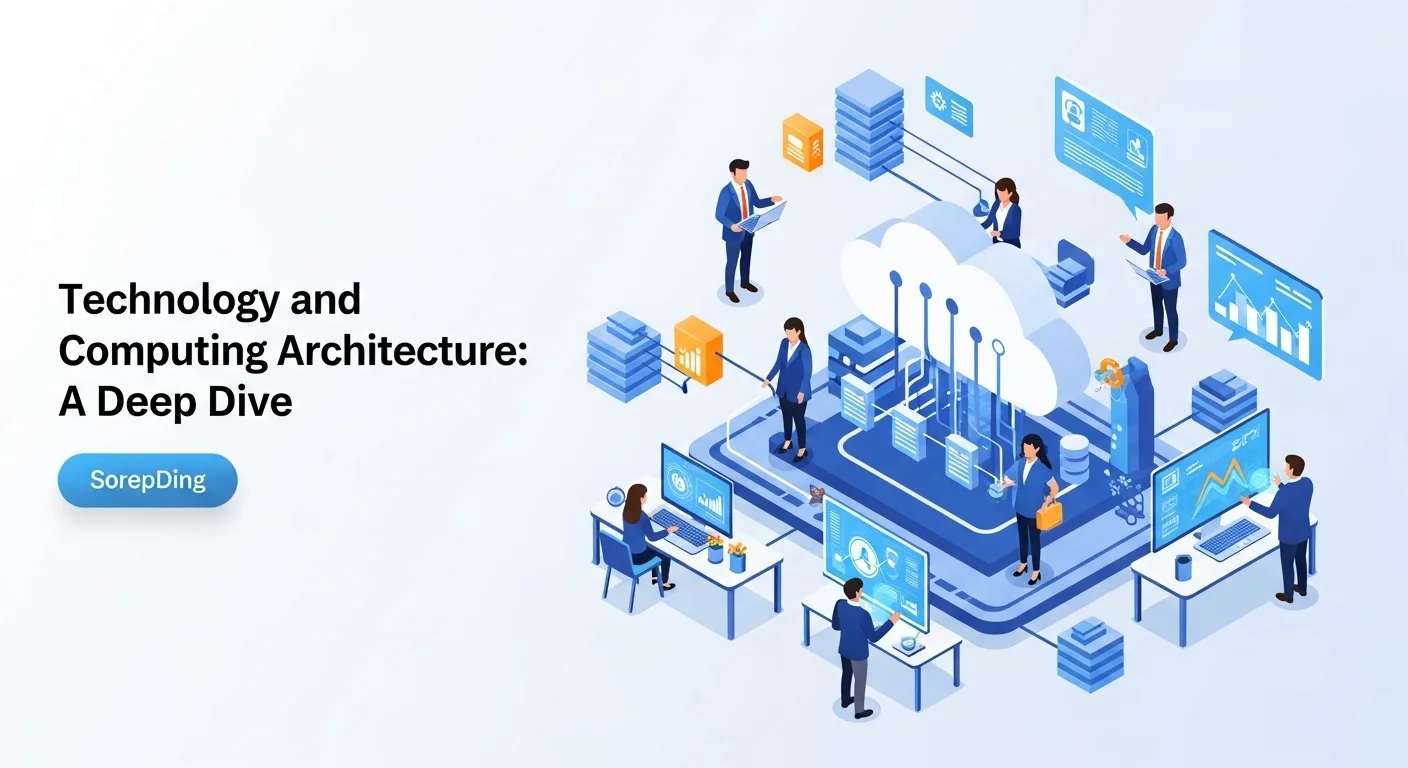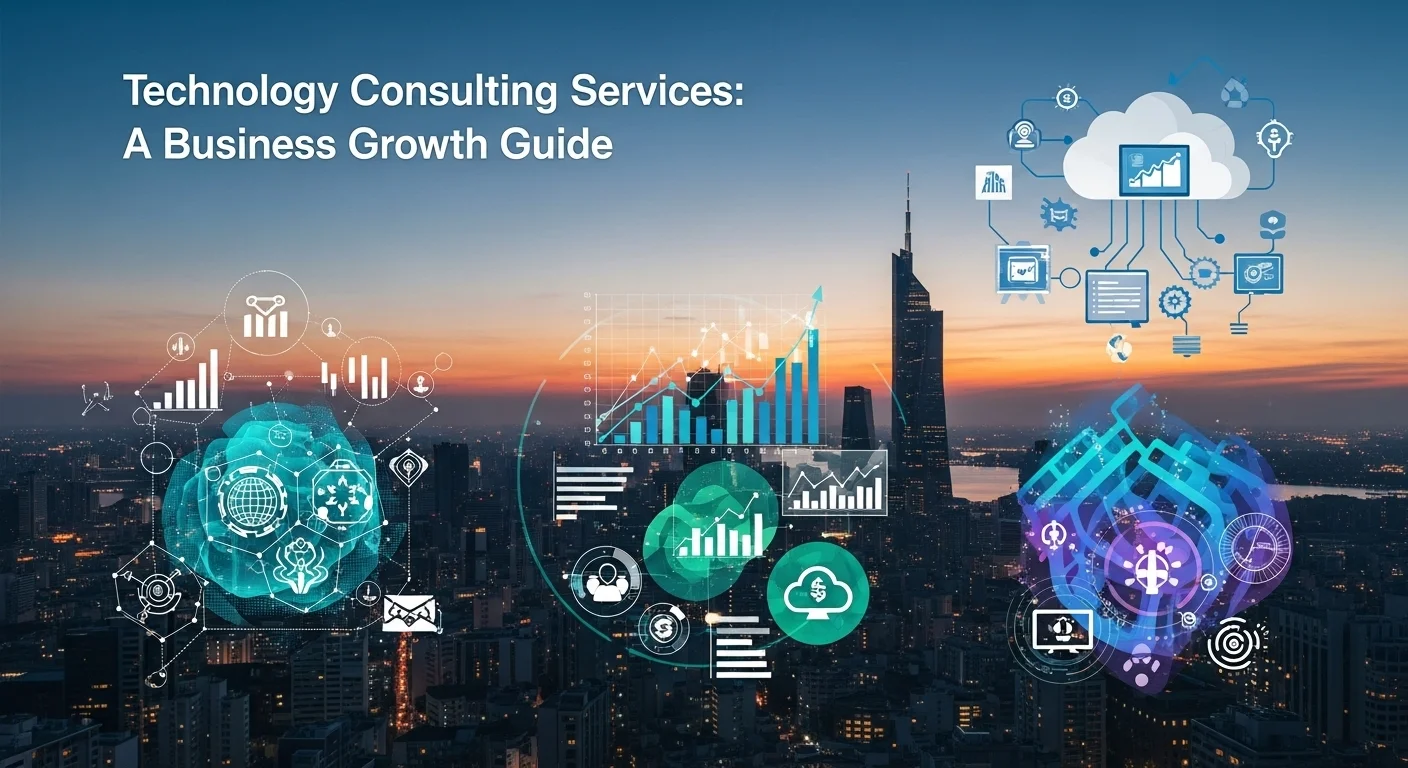Decoding Computing Architecture: A Real-World Guide for Tech and Business

Executive Summary
Ever wondered what's really going on behind the scenes of your favorite apps or the massive systems that run big companies? It all comes down to something called computing architecture. Think of it as the master blueprint for all things tech. In my years as a strategist, I've seen how getting this blueprint right is the secret to success. In this guide, I'll walk you through this fascinating world in simple terms. We'll start with the basics, move on to the cloud revolution that changed everything, and even peek into the ultra-secure systems that protect critical data. By the end, you'll understand not just *what* architecture is, but *why* it's the key to building efficient, secure, and innovative technology for any goal, big or small.
Table of Contents
- What Exactly Is Computing Architecture?
- The Big Shift: Moving to the Cloud
- Blueprint for Big Business: Enterprise Architecture
- Building on Bedrock: Secure Cloud Architecture
- Lessons from the Gold Standard: The DoD's Security Blueprint
- It's All About the Apps: Cloud Application Design
Understanding the Blueprint of Modern Technology
At its heart, Computing Architecture is the master plan for a computer system. Think of it like the architectural drawings for a skyscraper; it defines how everything fits and works together. It’s the set of rules that tells the hardware and software how to communicate to get things done. This isn't just abstract tech talk; it's a field that shapes everything from the phone in your pocket to the huge data centers that power our digital world. A smart architectural choice leads to speed, efficiency, and security. A poor one, which I've unfortunately seen happen, can create system bottlenecks, leave gaping security holes, and make it impossible to grow. It’s the foundation upon which all digital innovation is built.
So what are the core components? You have the Central Processing Unit (CPU), the 'brain' that follows instructions. Then there's the memory architecture—a hierarchy of super-fast caches, main RAM, and long-term storage—which determines how quickly the brain can access information. Finally, the Input/Output (I/O) system is how the computer talks to the outside world, from your keyboard to its network connection. How these pieces work in harmony is what makes a computer functional. For decades, a concept called the Von Neumann architecture, which stores instructions and data together, has been the bedrock of most computers we use. Grasping these fundamentals is the first step to truly appreciating the power and elegance of the systems we rely on every day.
The Big Shift: Moving to the Cloud
The game completely changed with the rise of the internet, pushing traditional architecture to evolve into what we now call cloud computing architecture. When we talk about the cloud's architecture, we’re describing a system with a user-facing front end (your device), a massive back end (the 'cloud' itself with its servers and storage), and the network that connects them. This setup lets companies deliver all sorts of computing services—servers, databases, software, and more—over the internet. Instead of buying and managing their own expensive hardware, businesses can 'rent' these resources from providers like Amazon Web Services (AWS), Microsoft Azure, or Google Cloud.
The impact of this shift has been massive. It’s leveled the playing field, allowing small startups to access the same computing power as global corporations without needing millions in upfront investment. The benefits are clear: you only pay for what you use, you can scale up or down instantly, and you get top-tier performance and reliability. It's the engine driving the modern economy, from your Netflix stream to complex scientific research.
Blueprint for Big Business: Enterprise Architecture
For large organizations, a generic cloud setup isn't enough. They need what we call an enterprise cloud architecture. This isn't a single product but a custom strategy that blends different types of clouds—private (on their own premises), public (like AWS), and hybrid (a mix of both)—into one seamless IT environment. As an architect, my job in these scenarios is to juggle integrating old systems, meeting strict regulations, and managing costs for the long haul. The ultimate goal is to build a flexible infrastructure that helps the business move faster, expand globally, and make smarter, data-driven decisions.
Building on Bedrock: Secure Cloud Architecture
Running parallel to all this is the absolute necessity of security. A secure cloud architecture isn't something you bolt on at the end; it has to be baked in from the very beginning. We use a strategy called 'defense in depth,' which means creating multiple layers of security. It starts with the physical security of the data centers and goes all the way up the digital stack. This includes tight controls on who can access what (Identity and Access Management), encrypting data whether it's being stored or sent over the network, and constantly monitoring for any suspicious activity. A solid security architecture protects a company's data, reputation, and bottom line.
Lessons from the Gold Standard: The DoD's Security Blueprint
When I want to point to the pinnacle of security, I always bring up the U.S. Department of Defense (DoD). Because of the incredibly sensitive nature of its data, the DoD has some of the strictest security requirements on the planet. Its architecture is a masterclass in risk management, guided by frameworks that define exactly how cloud services must be secured, authorized, and monitored. They classify data into different Impact Levels, with each level demanding tougher and tougher security controls. The principles developed for the DoD, like 'zero trust' (which means never trust, always verify), have become invaluable lessons for private companies aiming for the highest level of security. Adopting this mindset helps any organization build a more resilient and trustworthy system.
It's All About the Apps: Cloud Application Design
Finally, the world's best infrastructure is useless without well-designed applications. This brings us to cloud application architecture—how you build software to take full advantage of the cloud. The old way of building one giant, monolithic application just doesn't work well in a dynamic cloud environment. Instead, the modern approach is to use microservices, where an application is broken down into a collection of small, independent services. Think of it like building with LEGO bricks instead of carving from a single block of stone. This makes the application more agile, easier to scale, and more resilient. If one small service fails, it doesn't bring down the whole system. This symbiotic relationship between the infrastructure and the applications running on it is what truly unlocks the full power of today's technology.

Your Practical Guide to Choosing and Using Computing Architecture
A truly complete guide to computing architecture has to connect the dots between the technical details and real-world business goals. It's a journey from the physical hardware all the way to the cloud services we use every day. For any business, I've learned these aren't just IT decisions—they're strategic choices that define how fast you can move, how much you spend, and how you compete. This guide will walk you through the methods, business techniques, and resources you need to make smart architectural decisions.
The Technical Toolkit of Modern Architecture
The magic behind the cloud really starts with virtualization. A technology called a hypervisor allows a single physical server to act like multiple separate servers, which we call virtual machines (VMs). This is the key to how cloud providers can offer resources so flexibly. It’s the foundation. A more recent evolution of this idea is containerization, with Docker being the most famous example. Instead of creating a whole virtual server, a container just packages up an application and its dependencies. It’s much more lightweight and portable. To manage all these containers, we use orchestration platforms like Kubernetes, which has become the standard for automating how modern cloud applications are deployed and scaled.
Another crucial technical choice is your cloud deployment model. A private cloud is all yours, offering maximum control but also maximum cost and effort. A public cloud, from a provider like AWS or Azure, offers incredible scale with a pay-as-you-go model. In my experience, most large companies land on a hybrid cloud, mixing the two. This allows them to keep their most sensitive data on a private cloud while using the public cloud's power for everything else. Some even go a step further with a multi-cloud strategy, using services from several providers to get the best of all worlds and avoid being locked into a single vendor. Making this all work together requires some sophisticated networking and management.
Designing for Defense: The Secure Cloud
Building a secure architecture is absolutely non-negotiable. The industry has shifted from trying to build an impenetrable wall around the network to adopting a 'Zero Trust' model. The basic idea is simple: 'never trust, always verify.' We assume no user or device is safe by default, even if they're already inside the network. Every single request to access data must be authenticated and authorized. To do this, we rely on strong Identity and Access Management (IAM) policies, Multi-Factor Authentication (MFA), and network segmentation to isolate resources from each other. Data is protected with encryption, both when it's stored and when it's moving across the network. It's a continuous process of monitoring and responding to threats in real-time.
The rigor of the DoD's secure architecture provides a fantastic blueprint for the commercial world. A practice I always recommend, inspired by this discipline, is Infrastructure as Code (IaC). Using tools like Terraform, you define your entire infrastructure in code. This code can be versioned, reviewed, and scanned for security flaws before it's ever deployed, dramatically reducing human error. By studying how the DoD classifies its data and applies security controls, any business can create a smarter plan to protect its own most valuable digital assets.
Business Strategy for Architectural Success
Technology should always serve the business, not the other way around. That's why the first step in any architectural project is a deep dive into business needs. What are your most important applications? What are their performance and security requirements? A framework I've used with dozens of clients is the AWS Well-Architected Framework, which evaluates your setup against five pillars: Operational Excellence, Security, Reliability, Performance, and Cost. It's like a health check for your architecture.
Migration planning is another area where strategy is key. Moving applications to the cloud isn't a simple copy-paste job. We use a framework often called the '6 R's' to decide what to do with each application: Rehost (lift-and-shift), Replatform (a few tweaks), Repurchase (switch to a SaaS product), Refactor (rebuild for the cloud), Retire, or Retain. I've seen companies succeed by taking a phased approach, perhaps starting with a simple 'rehost' and then gradually 'refactoring' an application into modern microservices over time. This kind of thoughtful planning is what turns a technology project into a real business victory.
Choosing Your Partner: A Look at the Major Cloud Providers
Picking the right cloud provider is a huge decision. The big three—Amazon Web Services (AWS), Microsoft Azure, and Google Cloud Platform (GCP)—all have unique strengths. AWS is the market leader with the most services and a massive community, often the go-to for startups. Microsoft Azure is dominant in the enterprise world, especially for businesses already using Microsoft software, as it integrates seamlessly. Google Cloud shines in areas like data analytics, machine learning, and containerization, as it's where Kubernetes was born.
When I help clients choose, I tell them to look beyond the basic servers and storage. Compare their higher-level services for application development, databases, and AI. These are often the things that will truly accelerate your business. Also, consider their global footprint, performance, and pricing models. Many smart companies now use a multi-cloud approach to cherry-pick the best service for each job—maybe using Google for data warehousing while running web apps on AWS. This landscape is always changing, so staying informed is a critical part of an architect's job.

Actionable Tips for a Better, Cheaper, and Safer Tech Architecture
Getting your computing architecture right isn't a one-and-done project; it’s a continuous process of improvement. From my years in the field, I’ve gathered some tips and strategies that can make a huge difference in performance, security, and cost. This is the practical advice that helps you take control of your technology, especially in the powerful world of the cloud.
Best Practices for Enterprise Cloud Architecture
For any business, the number one best practice I preach is automation through Infrastructure as Code (IaC). Using tools like Terraform or AWS CloudFormation, you define your entire system in configuration files. The benefits are immense: it makes deployments repeatable and consistent, slashes the risk of human error, and gives you a perfect audit trail of every change. Managing these files with a system like Git brings the same discipline to your infrastructure that you have for your application code. This is the foundation of operational excellence in the cloud.
The second practice is creating a culture of cost management, which we call FinOps. The cloud's pay-as-you-go model is fantastic, but it can lead to shocking bills if you're not paying attention. A solid FinOps strategy involves a few key actions: tag every resource so you know exactly where money is going; use the cloud provider's cost tools to monitor spending; set up budgets and alerts; and use savings plans for your predictable workloads. From a design perspective, this means always choosing the right-sized servers, using auto-scaling to match demand, and moving old data to cheaper storage. FinOps is a team sport, requiring finance and tech to work together to make cost-aware decisions.
Strategies for a Resilient and Secure Architecture
A truly secure cloud architecture is built on a proactive, not reactive, strategy. The modern standard is the Zero Trust model. You have to assume your network is already hostile and verify every single request. In practice, this means enforcing strict identity checks for every user and device, giving them the absolute minimum permissions they need to do their job, and dividing your network into small segments to stop an attacker from moving around. This dramatically shrinks your attack surface.
Alongside security is resilience—designing your system to handle failure gracefully. In the cloud, this means spreading your application across multiple Availability Zones (which are separate data centers). If one fails, your application keeps running. For disaster recovery, you can even go multi-region. It's crucial to automate the failover process so traffic is rerouted instantly. I always push my teams to test these plans with 'chaos engineering'—purposefully trying to break things to make sure your recovery plan actually works. The mindset from the DoD's architecture—planning for the worst—is invaluable here; redundancy and automated recovery should be standard practice.
Improving Your Cloud Application Design
Your tech experience is only as good as the applications running on it. My top tip here is to evolve away from monolithic designs and embrace a microservices architecture. Breaking a big application into small, independent services makes you so much more agile and scalable. When you combine this with containers (like Docker) and orchestration (like Kubernetes), you have an incredibly powerful and efficient platform. You can scale just the one part of your application that's busy, instead of scaling the whole thing.
Another game-changing strategy is to use managed and serverless services whenever you can. Instead of managing your own database server, use a service like Amazon RDS. Instead of running a web server 24/7, use a serverless function like AWS Lambda that only runs when needed. The most evolved cloud architectures offload all the boring, heavy lifting to the cloud provider. This frees up your development teams to focus on creating features that add real business value, not managing infrastructure. This is the fast track to innovation.
Helpful Tools and Resources
To put these strategies into practice, you'll need the right tools. For monitoring, platforms like Datadog and New Relic give you incredible visibility. For security, tools like Splunk for log analysis and Prisma Cloud for posture management are essential. For Infrastructure as Code, Terraform is the multi-cloud standard. And for continuous learning, a resource I recommend to everyone is the collection of whitepapers in the AWS Well-Architected Framework. It provides fantastic, detailed guidance for building world-class systems on the cloud.
In the end, mastering computing architecture is about blending technical skill with business sense and a commitment to always getting better. By focusing on a smart enterprise architecture, building for security and resilience, and modernizing your applications, you can create systems that are powerful, efficient, and perfectly aligned with your goals.
Expert Reviews & Testimonials
Sarah Johnson, Business Owner ⭐⭐⭐
Good overview of Computing Architecture. As a business owner, I was hoping for more practical case studies to see how these concepts apply in the real world.
Mike Chen, IT Consultant ⭐⭐⭐⭐
A really helpful article on Computing Architecture that clarified a lot for me. Some of the deeper technical concepts could still be a bit simpler, but overall, a great read.
Emma Davis, Tech Expert ⭐⭐⭐⭐⭐
Fantastic and thorough article! As someone specializing in this field, I found the explanations of Computing Architecture clear, accurate, and incredibly useful. Highly recommended.



